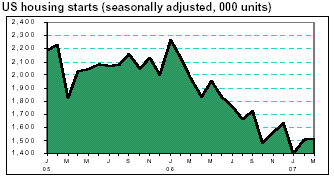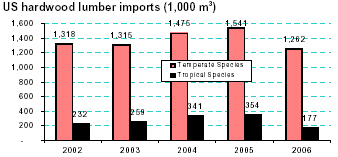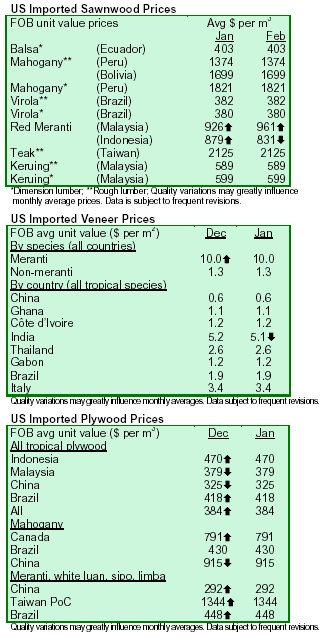|
US housing starts hold on amid lower forecast
Privately-owned housing starts recovered 0.8% in March to a seasonally adjusted annual rate of almost 1.52 million
units, according to the US Commerce Department. However, housing starts were 29.4% below the pace of a
year ago and 33.3% under the peak in January 2006 (see chart). The recovery was mainly due to a 2% increase in
the single-family sector, which accounts for about 80% of the houses built. Unseasonably warm weather in the
Midwest was believed to be the cause of the surge. Meanwhile, building permits surged (up 0.8% from
February) while housing completions fell (down 0.7%) in March. The National Association of
Home Builders (NAHB) reported that building confidence weakened in April. As a result, NAHB trimmed its starts forecast. It
now forecasts a 20% decline in 2007 to 1.44 million units.

DR Horton expects lower home sales
DR Horton, the largest US homebuilder by sales, warned that the US housing slump was still going strong as it
revealed a sharp drop in profits (down 26%) and said it had been forced to slash more than a quarter of its
workforce in the past year. The homebuilder cut 2,700 of its 10,000 staff amid the housing weakness. It cautioned it
expected lower home sales to continue and that the cuts came as part of an effort to reduce costs.
Donald Horton, chairman, said that the market conditions in the homebuilding industry
continued to be challenging in most US markets as inventory levels of both new and
existing homes remained high, and further increases in the use of sales incentives continued to put
pressure on profit margins. In addition, soaring defaults on ¡°subprime¡± loans
to people with poor credit histories has led to tightened lending practices, exacerbating the sector¡¯s woes.
US NGO loses mahogany lawsuit
The US Court of International Trade rejected the National Resource Defense Council¡¯s (NRDC) efforts to interfere
with internationally regulated trade in Peruvian mahogany. The Court dismissed on 16 April the NRDC lawsuit
against the US government and two private importers of Peruvian mahogany, stating that imports of mahogany
from Peru were accompanied by all CITES required environmental permits. The court also summarily denied
NRDC¡¯s motion for a preliminary injunction that would, if granted, have stopped a $60 million international trade
with Peru. Under the fee-shifting provisions of the Endangered Species Act, the court may require
NRDC to pay the legal expenses incurred by the private defendants in responding to the suit.
Bozovich Timber Products from Alabama and TBM Hardwoods from Pennsylvania, the
private defendants in the case, were pleased with the court decision.
US imports of hardwood lumber retreat in 2006
This first article analyses the trends of US hardwood lumber imports since 2002. It covers
tropical (HS Code 4407240005-4407290095) and temperate hardwood lumber (HS Code
4407910020-4407990096), but excludes logs, chips, veneer, plywood and other panel products.
Between 2002 and 2006 total US hardwood lumber imports grew from 1.55 million m3 to 1.89 million m3 in
2005, falling steeply to 1.44 million m3 in 2006, down 7.2% from 2002. The 2006 decline was a clear reflection
of the slowing US economy and sagging housing market.
Imported hardwood lumber experienced substantial price increases during the period. Setting the price index at 100
in 2002, it advanced to 131 in 2006, due partially to the weakening of the US dollar. Due to the steep price
increase, the import-value grew even though the volume declined. The value-growth rate between 2002 and 2006
was an estimated 21.3%. The total value of US hardwood lumber imports stood at $567 million in 2006.

Temperate hardwoods account for most of US hardwood
lumber imports, with a share of 88% and 77% on quantity and value basis, respectively. After several years of
decline, the temperate hardwood shares in 2006 were slightly higher than in 2002. The most imported temperate
hardwood species are poplar, aspen and similar species. However, the import of these species has been declining,
both in absolute and in relative terms during the period. Due to its lofty
price, the highest import value belongs to maple. In spite of generally declining imports of overall
temperate hardwood lumber, maple was able to hold its volume approximately at the same level and even improve
it in value terms compared to 2002.
The 2006 volume of US tropical hardwood imports stood at 176,806 m3, down from 231,615 m3 in 2002. The share
of tropical hardwood imports fluctuates with the economic cycle in the USA. On a volume basis, it has been
advancing for several years but fell significantly to 12% in 2006, down from 19% in 2005 and 15% in 2002. Tropical
hardwoods fetch a sizeable price premium in the USA in comparison to imported temperate hardwoods.
Nevertheless, during the period under review, prices of imported tropical woods grew relatively by much less than
prices of imported temperate woods. The price premium of tropical woods is rather volatile. In 2002, the average
price for tropical woods was almost three times as high as the one for imported temperate
woods. By 2006, tropical prices were only twice as high as temperate prices. Even
though the average price of tropical hardwood lumber is much higher than the average price of imported
temperate hardwood lumber, there are several temperate species that rival or even exceed the prices of tropical species. These
include, above all, cherry and walnut, averaging about $850 per m3 in 2006.

In view of the relatively high average prices of tropical
hardwoods, their share of total hardwood imports is much higher than their volume share. However, due to the often
diverging price trends of tropical and temperate species, the value share of tropical hardwoods in relation to total
hardwood imports is subject to significant variations. It reached around 34% in 2002-2005 but fell to 23% last
year. The most common tropical species imported by the USA include mahogany (mainly from Peru), balsa (mainly
from Ecuador) and red meranti (mainly from Malaysia).
California lowers formaldehyde levels in wood
California has recently adopted new standards to slash the amount of formaldehyde allowed in wood products. The
move was said to save people from getting cancer. Over objections from some businesses, the California Air
Resources Board (CARB) approved new rules intended to
reduce the total amount of formaldehyde released into the air in the state to 150 tons annually, down from the current
650 tons. According to CARB, the new rules will be the most stringent in the USA and, when fully implemented,
the most stringent in the world. Formaldehyde is used in
resins to bind together composite wood products. The new rules will be phased in starting in 2009 and fully
implemented by 2012. CARB indicated that the largest benefit would be realized by buyers of new homes due to
reduced indoor formaldehyde exposure. At a public hearing on the issue, some manufacturers warned the new
rules would lead to higher prices and argued
unsuccessfully they needed more time to adjust to the regulation.

|